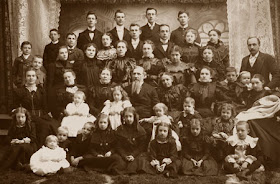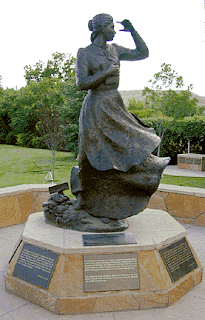HISTORICAL BACKGROUND
In the year 1918, Joseph F. Smith was the President of the Church, and his son, Hyrum Mack Smith, was one of the apostles. Joseph had a very close attachment to his son Hyrum, and always had. Hyrum had been ordained to the apostleship when he was only 29; now he was 45. He had recently returned from the harrowing experience of being the President of the European Mission and finding himself behind enemy lines in Germany when World War I broke out. Now, in January of 1918, he suddenly became ill and died, leaving his wife with four young children, and another one due in the fall.
Hyrum Mack Smith (left) with his parents,
Sarah and Joseph F. Smith
from FamilySearch.org
The year 1918 was a bad year for almost everyone. Besides the fact that World War I was well underway, causing death and destruction around the globe, another even greater catastophe struck. On March 11th, the company cook at Fort Riley, Kansas reported in sick with a fever, sore throat, and a headache. He was quickly followed by another soldier with similar complaints. By noon, the camp's hospital had counted over 100 ill soldiers. By the end of the week, the number reached 500.
The American soldiers shipping out to Europe to fight against Germany that spring did not realize that they carried a weapon more deadly than rifles, bombs, or cannons. The virus earned the name "Spanish Influenza" because eight million Spaniards died of it in May of that year. The Spanish Influenza killed faster and with less mercy than any weapon of war. It hit people from age 20-40 the hardest. In a matter of hours, a person could go from strapping good health to flat in bed unable to walk. Patients felt as if they had been beaten all over with a club. Fevers would reach 105 degrees, causing the victims to become delirious and hallucinate. In June, Great Britain reported 31,000 cases. By summer, the flu had spread to Russia, North Africa, China, Japan, the Philippines, and New Zealand.
The tide of the illness waned over the summer in the U.S., only to return with a fury in the fall. At Camp Devens, near Boston, it was reported that the dead bodies were "stacked about the morgue like cordwood." In one day there, 63 men died.
On September 24, in Utah, Hyrum Mack Smith's widow delivered her baby, but she died of the birthing process, leaving the prophet's five little grandchildren orphans. Many other Utahns lost loved ones at the same time, as that was the very week the Spanish Influenza hit Utah.
The War ended in November of 1918, but the flu raged on. In one week that month, the town of Brevig Mission, Alaska lost 85% of its population to the flu. 30,000 San Franciscans took to the streets to celebrate the end of the war. As over 2,000 citizens of their city had died of the influenza, the revelers were required by law to wear face masks. (Sound familiar?) On November 21st, sirens announced that it was now safe to remove the masks. The next month, 5,000 new cases of influenza were reported in San Francisco.
December 22nd was appointed by the Church leaders as a day of fasting "for the arrest and speedy suppression by Divine Power of the desolating scourge that is passing over the earth."
Then, as quickly and mysteriously as it came, the Spanish Influenza left. It waned in mid-winter (January), with a slight resurgence in the spring, never to be seen again. To this day, neither the cause nor the cure is scientifically known. The death toll in the U.S. was 675,000--10 times the number of Americans killed in the war, and 55,000 more than were killed in the Civil War. Half of the U.S. soldiers who died in Europe died of influenza, rather than of violence. Exact numbers cannot be found, but very possibly 50 million people worldwide died of influenza. The Spanish Influenza was the most devastating epidemic in world history. It killed more in one year than the Bubonic Plague killed in four.
A VISION OF HOPE FROM HEAVEN
It was during this year of devastation that the Great Vision of the Redemption of the Dead was given from Heaven to soothe the souls of mankind. President Joseph F. Smith had been confined to his bed for six months of 1918, suffering from pneumonia, and was very near death himself. He was not able to attend to the logistics of running the Church, but his enfeebled physical state made him even more capable of attending to the things of the Spirit. The afterlife was a topic utmost in his mind all year, as it was for people all around the world. President Smith had been especially close to this topic all his life, as his father, Hyrum Smith, had been killed when he was five, his mother, Mary Fielding, had died when he was in his early teens, and of his 49 children (44 biological and 5 adopted), 14 had died (nearly one-third). Because he had meditated, researched, taught, and testified about the redemption of the dead so faithfully all his life, and because he was currently pondering the scriptures on the matter, he was prepared and blessed to witness first-hand in a vision, exactly what happens to people after they die. Through this vision to President Smith, the Lord comforted the saints around the world who were suffering intensely because of the loss of their loved ones and the fear of dying themselves.
President Joseph F. Smith's family in 1898
President Smith wrote the revelation down two days after he witnessed it. Within weeks, the Quorum of the Twelve had voted to accept it as a revelation. Today this vision is in our Doctrine and Covenants as Section 138. The Great Vision of the Redemption of the Dead was an answer to the questioning prayers of many, many of Heavenly Father's children, received, written, and accepted as revelation in October 1918, a month when 195,000 Americans died of influenza, the deadliest month in the history of the United States. It is often in the most hopeless of situations that God reveals His love and His plans in visions of hope. And now all of us have the comforting knowledge that our departed parents, friends, and loved ones are still alive, involved in helping others, and very much active in teaching or learning the gospel though they have left our dimension.
It was during this year of devastation that the Great Vision of the Redemption of the Dead was given from Heaven to soothe the souls of mankind. President Joseph F. Smith had been confined to his bed for six months of 1918, suffering from pneumonia, and was very near death himself. He was not able to attend to the logistics of running the Church, but his enfeebled physical state made him even more capable of attending to the things of the Spirit. The afterlife was a topic utmost in his mind all year, as it was for people all around the world. President Smith had been especially close to this topic all his life, as his father, Hyrum Smith, had been killed when he was five, his mother, Mary Fielding, had died when he was in his early teens, and of his 49 children (44 biological and 5 adopted), 14 had died (nearly one-third). Because he had meditated, researched, taught, and testified about the redemption of the dead so faithfully all his life, and because he was currently pondering the scriptures on the matter, he was prepared and blessed to witness first-hand in a vision, exactly what happens to people after they die. Through this vision to President Smith, the Lord comforted the saints around the world who were suffering intensely because of the loss of their loved ones and the fear of dying themselves.
President Joseph F. Smith's family in 1898
Joseph F. and Julina Smith
Be sure to check out the December 2009 Ensign, which has a wonderful
article by BYU professor George S. Tate on President Joseph F. Smith,
his intimate acquaintance with death, the catastrophic loss of life in
World War I and the Spanish Influenza, and the great vision of the
redemption of the dead. It is a wonderful piece of writing, with additional details on the family deaths, and
some beautifully poetic journal entries President Smith wrote in his
loss. It also tells us that just before the pandemic mysteriously waned in January of 1919 and then disappeared for good (with just a brief resurgence the following spring), the Church leaders had designated December 22 as a day of fasting "for the arrest and speedy suppression by Divine Power of the desolating scourge that is passing over the earth." (George S. Tate, "I Saw the Hosts of the Dead," Ensign, December 2009, p. 54-59)
For a delightful accounting of Joseph F. Smith's intimate method of parenting, please see "The Fathering Practices of Joseph F. Smith," by Mark D. Ogletree, available at BYU Archives.
(Sources: Arnold K. Garr, et.al., Encyclopedia of Latter-day History; Robert L. Millet, Selected Writings of Robert L. Millet (Gospel Scholars Series); Molly Billings, www.stanford.edu/group/virus/uda; "American Experience" at www.pbs.org/wgbh/amex/influenza/; and "Grandpa Bill's General Authority Pages" at personal.bellsouth.net/lig/w/o/wo13/menu.htm)
For a delightful accounting of Joseph F. Smith's intimate method of parenting, please see "The Fathering Practices of Joseph F. Smith," by Mark D. Ogletree, available at BYU Archives.
(Sources: Arnold K. Garr, et.al., Encyclopedia of Latter-day History; Robert L. Millet, Selected Writings of Robert L. Millet (Gospel Scholars Series); Molly Billings, www.stanford.edu/group/virus/uda; "American Experience" at www.pbs.org/wgbh/amex/influenza/; and "Grandpa Bill's General Authority Pages" at personal.bellsouth.net/lig/w/o/wo13/menu.htm)




































